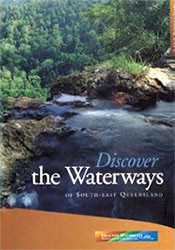Discovering Southeast Queensland waterways and rediscovering Liz Clarke
Bill Dennison ·One of the more enjoyable projects that I have done was co-author a book entitled "Discover the Waterways of South-East Queensland". The premise behind the book was to give people of Southeast Queensland a guide to viewing their streams, rivers and embayments. The guide was meant to also highlight the key processes and features of the waterways, which the photos and conceptual diagrams that accompanied the map of viewing locations would elucidate. The book was written as we were actively engaged in a suite of scientific studies to understand the catchment linkages to the waterways.
The manner that this book was written was the interesting aspect of the project. What we did was travel around Southeast Queensland to find viewing locations that were a) easily accessible, largely via automobile, and b) provided a vantage point for good views of waterways and catchments. These viewing locations included hilltops and docks and piers and we chose fine weather to maximize visibility. The team that traveled to these locations included Professor Stuart Bunn, Griffith University, Drs. Eva Abal and Cath Collier from Healthy Waterways and a writer, Liz Clarke. Stuart and I would have an unscripted wide-ranging talk about the visible features that could be related to the recent scientific understanding that we had gained, which Liz tape-recorded. Eva and Cath would take photos and notes for inclusion in the book and for developing conceptual diagrams for each vantage point. Liz used the tapes to write a cohesive story for each location, and the book was assembled by Eva and Cath.
A couple of things became apparent to me in the production of this book. First, virtually everything that we had rigorously established scientifically using sophisticated technologies was visible from the right vantage point. We could readily see gully and stream bank erosional processes, turbidity due to resuspension, and clear water in unimpacted areas. While the science was absolutely necessary for the rigor and demonstrable proof, it was amazing how well the science was confirmed by field observations, or alternatively, field observations were confirmed by science. Second, conducting the site visits with both a freshwater (Stuart) and marine ecologist (me) created a powerful synergy that also served us well with our subsequent book, "Healthy waterways, healthy catchments : making the connection in south east Queensland, Australia". Third, the process that Liz and I undertook after the site visits was to encapsulate the essential features of each region with as few words as possible was an interesting challenge. We now employ this technique widely in developing science communication products. Lastly, I gained a deeper appreciation of the wonderful diversity and beauty of Southeast Queensland catchments and waterways. This appreciation has developed into a deep passion for these waterways, and I am grateful for the timing of my sabbatical that I can be here during a period when I can offer some assistance following the dramatic floods.
A decade after this book was produced, I caught up with Liz Clarke. She had moved to a farm near Canberra, lived for a year in Syria and then a few years in Holland. She is about to embark on a PhD at the Australian National University in Canberra and was visiting her mother, Anne Clarke, a recent recipient of the National Riverprize for her Oxley Creek conservation efforts. Liz and I talked about science writing versus using narratives to tell compelling stories. Narratives derived from people talking about their experiences and perceptions are multi-dimensional and can provide a richness not present in scientific writing. Plus everyone loves a good story, and stories can be memorable and poignant. Significant events, like the recent Queensland floods, are often described in narrative form. One danger of relying exclusively on stories is that the subtle, incremental pressures can be lost as the large, highly visible event overshadows the processes that operate over much longer time frames.

Another topic that Liz brought up was 'seeking surprises', a seeming oxymoron that is an intriguing concept. Developing fluid management responses to new situations, rather than being either proactive or reactive is part of seeking surprises. The creation of new avenues or venues to cope with new exigencies can be viewed as a radical concept, particularly by governments that need to maintain order and continuity. Yet, emergency task forces that cut through red tape and are outcome oriented are examples of fluid management that can be very effective.
We also talked about tackling wicked problems, and Liz referred me to an analogy that her PhD supervisor, Dr. Valerie Brown, uses of chasing the tail of a lizard. Lizards have the ability when being chased by a predator to cast off their tails, which will twitch and captivate the predator's attention, as the lizard makes its escape. In tackling wicked problems, we often stay focused on the lizards' tails and lose sight of the lizard. Keeping focus on the real causes of environmental problems and working toward finding solutions to the problems, not just the symptoms, is often as difficult as keeping your eye on the lizard, not the tail.
About the author
Bill Dennison

Dr. Bill Dennison is a Professor of Marine Science and Vice President for Science Application at the University of Maryland Center for Environmental Science.
